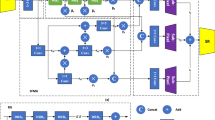Abstract
Sparse representation provides a new method of generating a super-resolution image from a single low resolution input image. An over-complete base for sparse representation is an essential part of such methods. However, discovering the over-complete base with efficient representation from a large amount of image patches is a difficult problem. In this paper, we propose a super-resolution construction based on multi-space sparse representation to efficiently solve the problem. In the representation, image patches are decomposed into a structure component and a texture component represented by the over-complete bases of their own spaces so that their high-level features can be captured by the bases. In the implementation, a prior knowledge about low resolution images generation is combined to the typical base construction for high construction quality. Experiment results demonstrate that the proposed method significantly improves the PSNR, SSIM and visual quality of reconstructed high-resolution image.











Similar content being viewed by others
References
Alfonso S, Gonzalo P (2008) Noniterative interpolayion-based super-resolution minimizing aliasing in the reconstructed image. IEEE Trans Image Process 17(10):1817–1826
Baker S, Kanade T (2002) Limits of super-resolution and how to break them. IEEE Trans Pattern Anal Mach Intell 24:1167–1183
Bertalmio M, Sapiro G, Caselles V, Ballester C (2000) Image impainting. Proceeding ACM SIGGRAPH, New Orleans, LA,(July 2000) pp:417–424
Cai JF, Hui J, Liu CQ, Shen ZW (2009) Blind motion deblurring from a single image using sparse approximation. Proceedings of IEEE Conference on Computer Vision and Pattern Recognition, (Jun. 2009)
Candes E (2006) Compressive sensing. Proceeding International Congress of Mathematicians, (2006)
Candes EJ, Wakin MB (2008) An introduction to compressive sampling. IEEE Signal Process Mag 25(2):21–30
Capel D, Zisserman A (2001) Super-resolution from multiple views using learnt image models. Proc IEEE Conf Comput Vis Pattern Recognit 2(II):627–634
Dong W, Zhang L, Shi G, Wu X (2011) Image deblurring and super-resolution by adaptive sparse domain selection and adaptive regularization. IEEE Trans Image Process PP(99):1
Elad M, Aharon M (2006) Image denoising via sparse and redundant representations over learned dictionaries. IEEE Trans Image Process 15(12):3736–3745
Herman MA, Strohmer T (2009) High-resolution radar via compressed sensing. IEEE Trans Signal Process 57:2275–2284
Irani M, Peleg S (1991) Improving resolution by image restoration. CVGIP: Graph Models Image Process 53:231–239
Landgrebe TCW, Duin RPW (2008) Efficient multi-class ROC approximation by decomposition via confusion matrix perturbation analysis. IEEE Trans. Pattern Analysis and Machine Intelligence, Vol: 30, Issue: 5, (May 2008) pp: 810 vol. 2
Lee H, Battle A, Raina R, Ng AY (2006) Efficient sparse coding algorithms. NIPS, (2006)
Li X, Orchard MT (2001) New edge-directed interpolation. IEEE Trans Image Process 10(10):1521–1527
Rauhut H, Schnass K, Vandergheynst P (2008) Compressed sensing and redundant dictionaries. IEEE Trans Inf Theory 54:2210–2219
Schultz R, Stevenson R (1996) Extraction of highresolution frames from video sequences. IEEE Trans Image Process 5:996–1011
Sun J, Zheng NN, Tao H, Shum HY (2003) Image Hallucination with Primal Sketch Priors. Proc IEEE Conf Comput Vis Pattern Recognit 2(II):729–736
Yang JC, John W, Ma Y, Huang T (2008) Image super-resolution as a sparse representation of raw image patches. Proc IEEE Conf Comput Vis Pattern Recognit, Anchorage, Alsk 2008:333–340
Yang JC, Wright J, Huang TS, Ma Y (2010) Image super-resolution via sparse representation. IEEE Trans Image Process 19:2861
Yang J, Zhang Y (2009) Alternating direction algorithms for L1-problems in compressive sensing. Rice University CAAM Technical Report, (2009) TR09-37
Zhang L, Wu X (2006) An edge-guided image interpolation algorithm via directional filtering and data fusion. IEEE Trans Image Process 15(8):2226–2238
Zhang X, Wu W (2008) Image interpolation by adaptive 2D autoregressive modeling and soft-decision estimation. IEEE Trans Image Process 17(6):887–896
Acknowledgments
This paper is supported by 973 Program (2011CB302703), NSFC (No. 61033004, 60825203, 60973056, 61170103, U0935004, 61003182), BJNSF (4102009, 4112007).
Author information
Authors and Affiliations
Corresponding author
Rights and permissions
About this article
Cite this article
Jing, G., Shi, Y., Kong, D. et al. Image super-resolution based on multi-space sparse representation. Multimed Tools Appl 70, 741–755 (2014). https://doi.org/10.1007/s11042-011-0953-4
Published:
Issue Date:
DOI: https://doi.org/10.1007/s11042-011-0953-4




